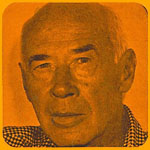
by Dr. Hugo Heyrman
a tribute to his work and life, books, art, loves & friends,
with an excellent collection of hard-to-find-Miller items
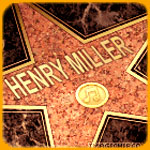
 |
Henry Miller Online by Dr. Hugo Heyrman a tribute to his work and life, books, art, loves & friends, with an excellent collection of hard-to-find-Miller items |
 |
FRIENDS |
| Alfred Perlès 'My Friend Henry Miller' | ||||
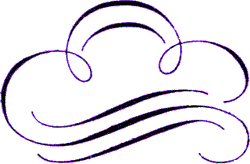 |
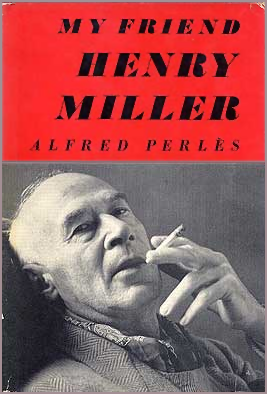 |
|||
Perlès and Miller maintained a life-long friendship. Miller visited Perlès in the UK and Perlès visited Miller in Big Sur, California, where he wrote 'My Friend Henry Miller' (written in 1954/55). Miller wrote a tribute to Perlès in the memoir Joey (Miller and Durrell often referred to Perlès as 'Joe'or 'Joey'). By 1936, Perlès was part of a vibrant Parisian literary scene that included Miller, Lawrence Durrell, and Anaïs Nin, as well as Antonin Artaud, and others.
|
||||
Perlès meets Miller for this first time, on rue Delambre in Paris 1928. Alfred Perlès was born in Vienna (1897), to Czech Jewish parents. |
Cover: Alfred Perlès, 'My Friend Henry Miller' New York: John Day (1956). |
|||
Henry Miller and Alfred Perlès |
||||
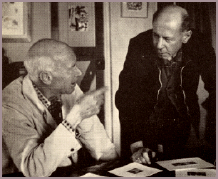 |
The Austrian Alfred Perlès and Henry Miller shared a flat at the working-class district of Clichy, Paris, where Miller worked on the 'Tropic of Cancer'. Miller’s creativity was at its most fecund in the Clichy apartment. He covered the walls of his room with large sheets of brown wrapping paper on which were scribbled notes and diagrams of his plans for novels, as well as photographs, pages torn from his favorite books and lists of exotic words he wished to incorporate in his writing. |
|||
Henry Miller and Alfred Perlès, Big Sur, 1954. (Photography: Wynn Bullock) In 1960, Gilbert Neiman is editor of 'Between Worlds': An international magazine of creativity, published in Puerto Rico and Denver. Significant in its calibre of contributors: Henry Miller, Man Ray, Marcel Duchamp, Herman Hesse, William Burroughs, Lawrence Ferlinghetti. Alfred Perlès contributed to an issue as well. |
In the fall of 1931, Miller was employed by the Chicago Tribune (Paris edition) as a proofreader, thanks to his friend Alfred Perlès who worked there. Miller took this opportunity to submit some of his own articles under Perlès name, since only the editorial staff were permitted to publish in the paper in 1934. | |||
Henry Miller and Lawrence Durrell
|
||||
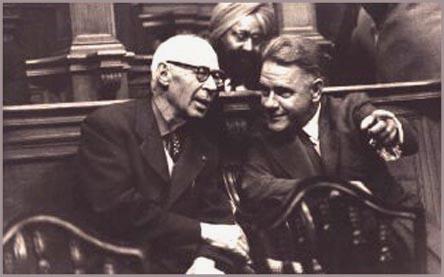 |
This period in Paris was highly creative for Miller, and during this time he also established a significant and influential network of authors circulating around the Villa Seurat. One author who became a life-long friend was the young British author Lawrence Durrell. "American literature today begins and ends with the meaning of what Miller has done." —Lawrence Durrell Lawrence Durrell was born on February 27, 1912, in Darjeeling, India, at the foothills of the Himalayas. |
|||
Henry Miller with Lawrence Durrell at the International Writer's Conference, Edinburgh, August 1962. Miller was the star of the conference. (Photo: The Scotsman publications.) |
"Henry Miller (my dad) had many friends throughout his life that were true lifelong relationships. He was a loyal friend. He loved to laugh and share meals and wine, always exchanging ideas about literature and art. He truly enjoyed life and made the world a better place by his wholehearted embrace of the world. He was tolerant, kind, inspiring, droll, genuine, loving, intelligent, thoughtful, a wonderful combination of many talents, humble as well as proud." —Valentine Miller |
|||
| Portrait of Blaise Cendrars as a young artist, 1907 | ||||
| For Miller, the first concrete sign of appreciation comes from Cendrars, in the form of a review of 'Tropic of Cancer', that is the very first recognition of Henry Miller's novel in print. Henry Miller's enthusiasm for the Parisian avant-garde poet-turned-novelist Blaise Cendrars, is well know. They have a good deal in common; both Cendrars and Miller present themselves to the public as livers rather than artists. Miller has written about Cendrars extensively and admires him greatly as one of his hero's. He hailed him as the man "exploding in all directions at once." "Cendrars has made it clear that the only teacher, the only model, is life itself. What a writer learns from Cendrars is to follow his nose, to obey life’s commands, to worship no other god but life." —Henry Miller (The Books in My Life) "Language is not something dead, frozen, but something in motion, fugitive, attaching itself always to life and reality." —Blaise Cendrars (1887-1961) |
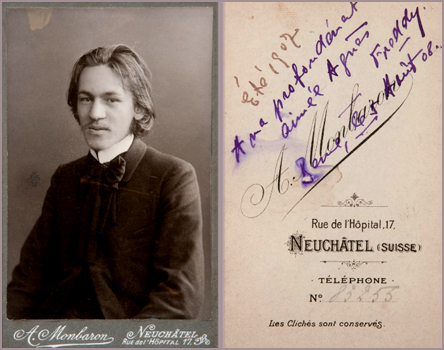 |
|||
Reading Blaise Cendrars is like stepping into another universe. Blaise Cendrars is one of the first to introduce modernity into twentieth century poetry. Blaise Cendrars, Swiss novelist and poet naturalized French in 1916. (September 1, 1887 – January 21, 1961). |
Portrait-visit card representing young Blaise Cendrars (91 x 60 mm) Dated: Summer 1907. Pasted on a paperboard with the address of A. Monbaron, in Neuchâtel, rue de l'Hôpital, 17, Suisse. Rare portrait of Blaise Cendrars, with a note to his sister-in-law: "To my deeply loved Agnès, Freddy. Bern, on August 5, 1908 " |
|||
Blaise Cendrars by Amedeo Modigliani |
||||
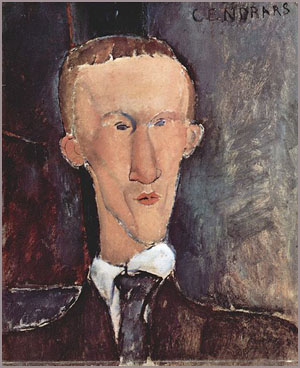 |

|
|||
| Blaise Cendrars was a friend of Henry Miller as well as many of the writers, painters, and sculptors living in Paris. In 1918, his friend Amedeo Modigliani painted his portrait. Miller and Cendrars soon became friends in Paris and would write to each other regularly over the course of forty-five years. As a result of praise from writers such as, Blaise Cendrars, George Orwell, and Ezra Pound, Henry Miller's book 'Tropic of Cancer' gained a reputation as an underground classic. |
||||
| Amedeo Modigliani, 'Portrait of Blaise Cendrars', 1918. (Oil on cardboard, 61 x 50 cm.) Private collection. |
||||
| Emil Schnellock, Henry Miller's Boyhood Friend | ||||
"You're the one person back home I always kept in mind. I thought of you more than you will ever realize." (Henry Miller to Emil Schnellock, Letters To Emil, p. 158) Emil R. Schnellock was only a year older than Henry Miller, but served as his mentor at crucial moments in his life. Schnellock taught Miller to paint, enriched his understanding of Art, helped inspire him about Paris, acted as a critic of his writing technique and encouraged him to loosen it up, solicited articles on his behalf, acted as his 'literary executor', and was generally the sounding board off of which Miller develped his style. Henry Miller had always loved art. He first began painting after seeing some Turner prints in a Brooklyn department-store window. There was only one minor drawback: he couldn’t draw. But his best friend, Emil Schnellock, could, and Miller became his disciple. It wasn’t long before he realized that what he lacked in draftsmanship, he made up for in color and composition sense. |
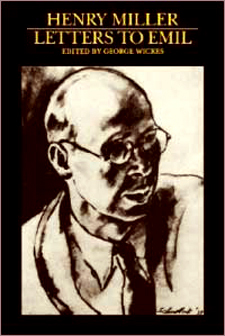 |
|||
'The Miller/Schnellock Archive' at the 'The Henry Miller Library' contains 187 letters from Miller to Schnellock spanning 40 years of friendship. The letters were written between 1922 and 1934, most of them during Miller's first few years in Paris. |
'Letters To Emil' by Henry Miller, Emil Schnellock, George Wickes (Editor) Publisher: New Directions Publishing Corporation, 1st edition (July 1989). Cover: Conté drawing of Henry Miller by Emil Schnellock, 1929, (courtesy of UCLA Special Collections). | |||
'Shakespeare and Company', Paris 1919
|
||||
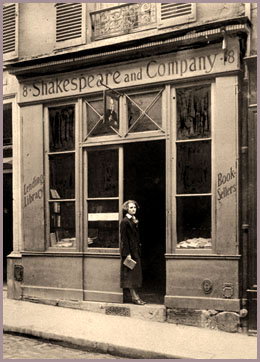 |
'Shakespeare and Co' is today a Paris-based bookshop, as it was nearly a century ago when it was opened in 1919 by Sylvia Beach, an American living in Paris. Sylvia Beach recommended Henry Miller for publication to Jack Kahane. |
|||
Sylvia Beach, publisher, before her bookshop, 'Shakespeare & Company', 37 rue de la Bûcherie, Paris |
||||
| Letter from Henry Miller To Man Ray, 1947 | ||||
| Fascinating is the fact that Henry Miller has chosen to honor Man Ray by using his painting, 'Observatory Time —The Lovers' from 1934, as a letterhead. The handwritten letter from Henry Miller to Man Ray, is dated 2/5/47. (At that time, Man Ray was living in Hollywood).
|
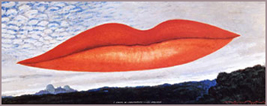 |
|||
It was in L.A. that Man Ray met Juliet Browner, who was to become his wife and muse for the remainder of his life. He also formed bonds with the writer Henry Miller. Like Man Ray, Miller arrived in Los Angeles in 1940, where he took up residence with Margaret and her husband Gilbert Neiman, an artist and writer, sometimes joined by Man Ray and his wife, they would often speak of Art. |
Red colour painting lips flying in sky over a forest (Original french title: A l'heure de l'observatoire, les Amoureux), 1934. | |||
Miller with Salvator and Gala Dalí |
||||
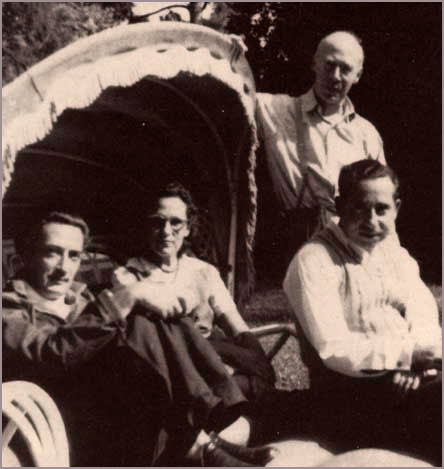 |
||||
Left: Miller with Salvator and Gala Dalí, the third man is Barnet Ruder. (Photographed at Caresse Crosby's home in the summer of 1940) |
Dalí's film collaborations with Buñuel liberated Miller from respect for conventional form in Art. Or, as Henry Miller wrote in 'Tropic of Cancer': "Every man with a bellyful of the classics is an enemy to the human race." | |||
| Henry Miller with his friend Gilberte Brassaï | ||||
With his friend Gilberte Brassaï, who gained fame as a photographer, Miller shared love of the city at night. "I have found my counterpart in dear Halász", he said to his literary agent, Frank Dobo, "a wanderer like me, who sets out on an exploration with no other aim but continual investigation." Miller also wrote an article on Brassaï, 'The Eye of Paris', stating: "Perhaps the difference which I observe between the work of Brassaï and that of other photographers lies in this —that Brassaï seems overwhelmed by the fullness of life." |
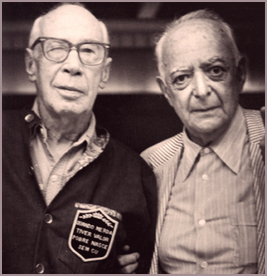 |
|||
Brassaï captured the essence of the city in his photographs, published as his first collection in book entitled 'Paris De Nuit' (Paris by Night) 1933. His book gained great success, resulting in his being called 'The Eye of Paris' in an essay by his friend Henry Miller. Brassaï photographed many of his artist friends, including Salvador Dalí, Pablo Picasso, Henri Matisse, Alberto Giacometti, and several of the prominent writers of his time, such as Jean Genet and Henri Michaux. |
||||
Brassaï, born Gyula, Jules, Halász, in Brassó, Transsylvania, Austria-Hungary (Now Romania), (9 September 1899–8 July 1984) was a photographer, sculptor, and filmmaker who rose to international fame in France in the 20th century. |
Miller and Brassaï in Pacific Palisades (Los Angeles), June 28, 1973 | |||
George Orwell and Henry Miller |
||||
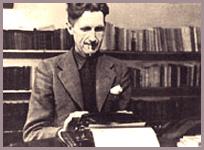 |
When English writer George Orwell traveled to Spain in 1936, to report on the Civil War, he stopped in Paris to meet Henry Miller, who told him he was a pacifist. "Here in my opinion is the only imaginative prose-writer of the slightest value who has appeared among the English-speaking races for some years past." —George Orwell |
|||
| In 1937, Henry Miller had come to London with Lawrence Durrell, to visit Perlés, T.S. Eliot and Dylan Thomas (Dylan greatly admired Miller). Miller, Durell and Perlés were at that time editing an English language magazine in Paris together, originally called 'The Booster' and later 'Delta'. | ||||
| Henry Miller 'My Bike & Other Friends' | ||||
Contents: I. Harolde Ross II. Bezalel Schatz III. Vincent Birge IV. Emil White V. Ephraim Doner VI. Jack Garfein VII. Joe Gray VIII. My Best Friend (his bike) "I have begun a big book - 'The Book of Friends', I am calling it tentatively", wrote Miller to Lawrence Durrell on January 3, 1973. "It's easy going, to my liking. Simple, nostalgic, perhaps even sentimental at times". . . "The past is like an open book —rather, a cinerama spactacle. Nothing is ever lost, what! Have 30 friends listed. Hope I can finish it before I croak." (The Durrell-Miller Letters 1935-80, ed. Ian MacNiven, p. 461) |
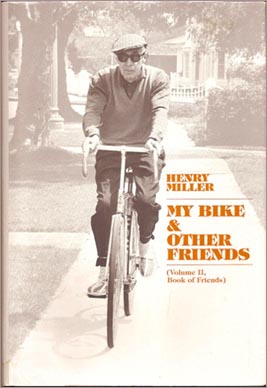 |
|||
| Henry Miller, Book of Fiends, (Volume II) | ||||
Henry Miller, Beach, Santa Monica |
||||
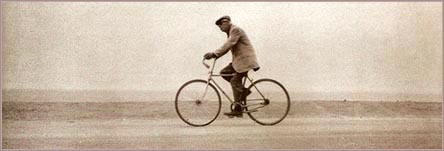 |
||||
Henry astride his best friend on Beach, Santa Monica 1975 (Photography: Peter Gowland) |
|
|||
Henry Miller 'Book of Friends' |
||||
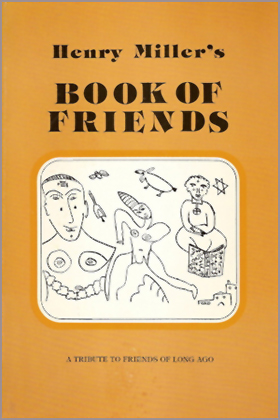 |
When I say friends, I mean friends. Not anybody and everybody can be your friend. It must be someone as close to you as your skin, someone who imparts colour, drama, meaning to your life . . . A life without friends is no life, however snug and secure it may be" —Henry Miller Henry Miller began his Book of Friends in 1973 with the idea of rendering homage to the friends in his life, most of them unknown to the public. He writes about childhood friends, his first love, friends from his European, Big Sur and Pacific Palisades years, women he knew and loved, and his bike. Contents: I. Stasiu (Stanley Borowski) II. Joey And Tony (Imhof, really Insley) III. Cousin Henry IV. Jimmy Pasta (Tony Marella) V. Joe O'Reagan VI. Max Winthrop VII. Alec Considine The book was released in limited and trade editions by Capra Press in 1976, then as a paperback in 1977. The U.S. cover was adorned with a Miller watercolour he titled 'Happy Days.' |
|||
A tribute to friends of long ago, Publisher: Capra Press (June 1976) |
||||
| Norman Mailer and Henry Miller in 1962 | ||||
In 1969 the feminist writer Kate Millet attacked Miller in his book 'Sexual Politics', and two years later Norman Mailer defended him in 'The Prisoner of Sex'. Mailer locates lust as the driving force of Miller's writing and the key to his genius. He then chooses substantial passages from Miller's major works to demonstrate how Miller has fused the erotic, the social and the cosmic to create some of the most prophetic prose to be found in the English language. According to Norman Mailer, Henry Miller "at his best wrote a prose grander than Faulkner’s, and wilder —the good reader is revolved in a farrago of light with words heavy as velvet, brilliant as gems, eruptions of thought cover the page." In 1976 Norman Mailer edited a selection of Miller's writings: 'Genius and Lust', in his book, Mailer called 'The Tropic of Cancer' "One of the ten or twenty greatest novels of the century". |
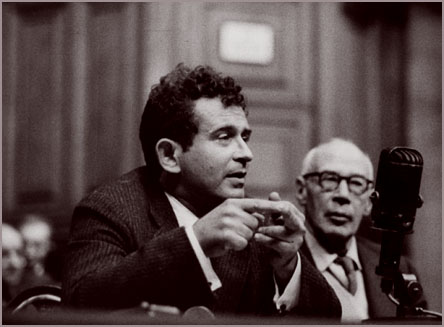 |
|||
Norman Mailer, 'Genius and Lust: A Journey Through the Major Writings of Henry Miller',
Publisher: Grove Press;
First Edition edition (1976) |
Norman Mailer (January 31, 1923 – November 10, 2007) was an American novelist, journalist, essayist, poet, playwright, screenwriter and film director. | |||
| Hildegard Knef & Henry Miller | ||||
 |
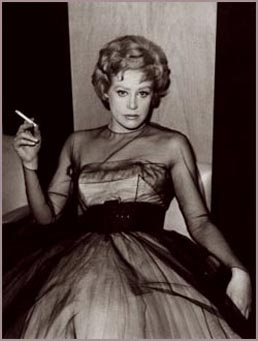 |
|||
| Born in Ulm, Germany, in 1926, Knef grew up in wartime Berlin where she was one of the country's first big, post-war screen stars. Knef was not only a film talent, but also a gifted artist and fashion designer, and as her correspondence shows maintained close links with a string of famous personalities including Henry Miller and Marlene Dietrich among others at various periods in her life. | ||||
| Hildegard Knef: "… genau. Einer meiner nächsten Freunde war Henry Miller. Seine Ich-Form hat mich dazu inspiriert, ebenfalls in der Ich-Form zu schreiben. Ich war mit Boris Vian befreundet, gehörte in Paris jahrelang zu den Dadaistenzirkeln." (Source: FACTS, 7. December 1995) |
May 1961, in Hamburg, shooting for the TV production Golden Boy; during that time beginning of Hildegard Knef life-long friendship with US author Henry Miller. (Photo: Hamburg 1961) Hildegard Knef über Henry Miller, "Er ist mein großer Freund." (Source: Twen, Nr. 9/1964) |
|||
| Dinner with Henry Miller: a glimpse into the mind of one literature’s great provocateurs | ||||
With him at the table is the film crew, and actress/model Brenda Venus, to whom Henry Miller was enamoured in the final years of life. Henry Miller (at age 87) spends the majority of his time speaking on a number of subjects, the most persistent of which is Blaise Cendrars. |
||||
’Dinner with Henry’ is exactly what the title suggests. Over a plate of food and glass of wine, the 87 year old Buddha of Brooklyn enthusiastically riffs on his hero's. Shot by Richard Young and John Chesko in 1979, this ’lost’ documentary has recently surfaced and it’s a wonderful peek into the life of one literature’s great provocateurs. |
||||
Henry Miller and Emil White of Anderson Creek |
||||
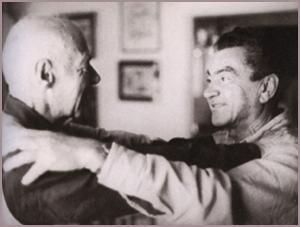 |
"To Emil White of Anderson Creek —one of the few friends who has never failed me." —Henry Miller (Dedication to 'Big Sur and the Oranges of Hieronymus Bosch') White was a faithful friend of Miller for over 25 years. In 1981, Emil White established the 'Henry Miller Memorial Library' at his home, where he displayed his own work, paintings by other local artists and his collection of Henry Miller memorabilia. Mr. White donated his home to the 'Big Sur Land Trust', which is to continue to operate it as a museum: "to promote and enhance the scholarly research and worldwide enjoyment of Henry Miller's literary and artistic works.” |
|||
Emil White, who was born in Austria, began his painting career about 1944, after being introduced to Big Sur by his friend, the writer Henry Miller, who lived in the area. |
Emil White, who served as Miller’s personal assistant, moved to Big Sur in 1944 with Miller. Paid $5 a week to handle Miller’s correspondence, White became one of the writer’s closest friends. | |||
The Henry Miller Memorial Library |
||||
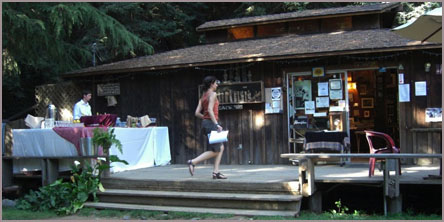 |
 |
|||
| The 'Henry Miller Memorial Library' is located in Big Sur, California, 35 miles south of Carmel-by-the-Sea on Highway One, the Library occupies the former home of long-time Miller friend Emil White, who established it as a fitting permanent memorial to Miller and especially to his years (1944-1962) writing and painting in Big Sur. | ||||
| Suggested 'Henry Miller' Links | ||||
 |
Henry Miller: Personal Collection www.henrymiller.info Nexus: The International Henry Miller Journal www.nexusmiller.org Cosmodemonic Telegraph Company: A Henry Miller Blog cosmotc.blogspot.com Henry Miller Online by Dr. Hugo Heyrman doctorhugo.org/henry/miller.html Henry Miller: The 100 Books that Influenced Me Most www.doctorhugo.org/henry/100-books.html Henry Miller, Bibliography (1934—1980) www.doctorhugo.org/henry/bibliography.html Henry Miller Memorial Library, Big Sur California www.henrymiller.org Wikipedia entry on Henry Miller en.wikipedia.org/wiki/Henry_Miller |
|||
FRIENDS |
| ( ( ( motions of the mind ( ( ( |